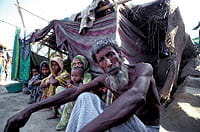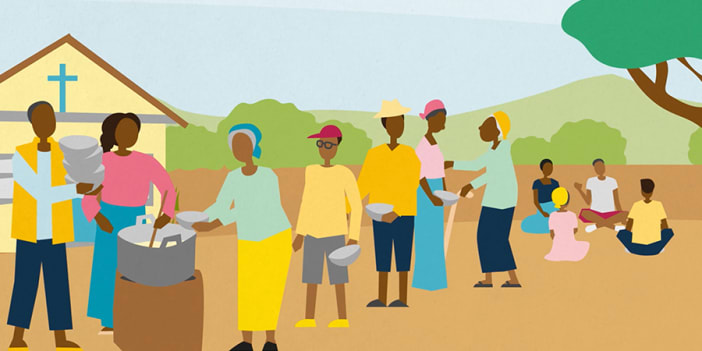by Marcus Oxley.

Articles
Responding to disasters
Every community, no matter how poor, possesses both strengths and weaknesses which can affect its ability to respond to a disaster
2003 Available in English, French, Spanish and Portuguese

From: Learning from disaster – Footsteps 56
Advice on how communities can prepare for the unexpected

Photo: Jim Loring/Tearfund
What do we mean by a disaster? A disaster is any kind of crisis that happens when people are unable to cope with the impact of an event that causes severe damage or destruction. The term hazard is used to describe such an event. Hazards can be either natural or man-made and include earthquakes, floods, epidemics, wars or economic collapse. The term vulnerable is used to describe people who are likely to suffer serious loss, damage, injury or death as a result of any kind of hazard.
Vulnerable people, who are often poor, will find it hard to respond to, and recover from, the impact of a hazard. For example, economic pressures may force people to live in dangerous locations, such as flood plains or low-lying coastal areas. They are then vulnerable to flooding or storms. People who have more financial resources can choose not to live in such dangerous places and may be able to strengthen their homes against the impact of flooding.
The poorest people in society are generally most at risk from the impact of disasters. However, people with disabilities, the elderly and the very young are also vulnerable in difficult situations.
A hazard only becomes a disaster when it is experienced by vulnerable people.
Every community, no matter how poor, possesses both strengths and weaknesses which can affect its ability to respond to a disaster. If weaknesses within a community are seen as vulnerabilities, then strengths can be considered as the capacity of the community to cope with, and recover from, hazards.
Increasing impact of disasters
Since the 1960s there has been a rapid rise in the number of deaths and injuries from disasters. During the 1990s around 80,000 people were killed by natural disasters each year, and 200 million people suffered serious problems as a result of disasters each year. There were more natural disasters in the year 2000 than in any of the previous ten years.
Even more people are affected by conflict. During the 1990s over 31 million people each year were affected by conflicts, with around 230,000 people killed each year.
The increasing impact of natural disasters may be partly due to an increase in droughts, floods and storms as a result of long-term climate change. However, the main reason is because of increased poverty. Each disaster is likely to leave poor people in a worse situation than before, and even more vulnerable to a future disaster. In addition, the impact of war has brought sudden poverty to many millions of people.
Why do disasters happen?
Disasters are rarely isolated events. They show in painful and practical ways the consequences of mankind’s broken relationship with God. When people are not accountable to God or to each other, this may lead to selfish attitudes, values and behaviour. The rich ignore the needs of those who are poorer. Richer, more powerful individuals and countries try to keep their privileged position through the special rules and structures they establish. The consequences are a world with a growing gap between rich and poor, increasing environmental damage and climatic change and rapidly growing slum areas in cities.
What is our response?
The increase in disasters threatens any social, political and economic progress made in recent decades. Reducing the threat of disasters on vulnerable communities is central to the very success of development itself.
When they occur, disasters can seem overwhelming, but remember that if a community builds up its capacity to cope with disasters, it will suffer much less. If we can tackle the causes of vulnerability and hazard, we may be able to prevent future disasters. In the words of the UN Secretary General, Kofi Annan:
‘We must shift from a culture of reaction towards a culture of prevention. Preventative action is not only more humane than curative measures, it is also more cost-effective. ’
Reducing the impact of hazards
We cannot prevent hazards from occurring, whether natural or man-made. However, practical action can be taken beforehand to reduce the potential impact of hazards on a community so that they do not always lead to a disaster. This is known as mitigation. Some actions can be taken by community organisations or churches without outside help. Other action may need financial or other support from local authorities or outside organisations. Such action must be carefully targeted to deal with the type of hazard likely in that area. Examples include:
- building flood protection dykes
- improving drainage
- building earthquake- or flood-resistant housing
- planting trees, particularly on steep slopes to reduce
- rainwater run-off and in coastal areas to reduce storm damage
- soil conservation measures
- peace-building and reconciliation
- improving food security
- land reforms.
Preparing for natural disasters
In countries where natural hazards occur regularly, people use their knowledge and resources to cope. Local people can build up their capacity to respond, should an unexpected hazard occur. In poor countries, local people, churches and community-based organisations are already active. At times of crisis they will play the main role in meeting the basic needs of the community. Building capacity to respond to possible hazards is one of the most effective ways of reducing the risk of disasters.
Some practical examples of such preparation include:
- early warning systems
- first-aid training
- evacuation plans for people and livestock to ‘safe areas’
- building storm or flood shelters
- developing local leadership
- encouraging local networking.
Emergency response
If a disaster does happen, most people are saved and helped by local people, long before outside help arrives. There are many small disasters that never receive outside help. However, disaster situations often overwhelm the capacity and resources of the community and local authorities. They need outside emergency help.
Outside help will always have a long-term impact on a community. Well-intended, but badly designed relief projects can make people dependent on outside help and reduce their capacity to cope. Whenever possible, outside help should strengthen local capacities and livelihoods so that recovery will be sustainable and long term.
Advocacy work
Advocacy work seeks to tackle the underlying causes of disasters by influencing key decision-makers at all levels to develop policies that support the poor and reduce their vulnerability.
Such change is unlikely to happen unless local organisations help vulnerable people to organise themselves, make their needs clear and start demanding better services and support. The church can play a lead role in this empowering process since it is present in many local communities and has strong moral authority.
Changes at the community level need to be combined with changes in both national and international policies.
The positive impact of disasters
Disasters can be key events for learning, education and development. They remind us of how much we depend on God and that all things are connected. God can use disturbing events in our world to change hearts, minds and lives.
At the time, disasters are awful for those involved. However, benefits can come to the wider community as a result of a disaster.
- Disasters can mobilise public opinion, influence decision-makers and raise substantial financial resources.
- Disasters can bring a sense of urgency and strengthen political commitment for change.
- Disasters provide a unique opportunity for the poor and powerless to speak up against injustice and prejudice.
Preventing disasters in the future will depend on our ability to build just and fair social, economic and political structures that are based on Christian values of love, honesty and compassion
At Tearfund, our aim is for all our work in disaster management to show Christ’s love in action. In doing this, we believe the work contributes towards reconciling relationships between people, with their environment, and with God.
Marcus Oxley is the Disaster Management Director at Tearfund.
Similarly Tagged Content
Share this resource
If you found this resource useful, please share it with others so they can benefit too.

Subscribe to Footsteps magazine
A free digital and print magazine for community development workers. Covering a diverse range of topics, it is published three times a year.
Sign up now - Subscribe to Footsteps magazine





